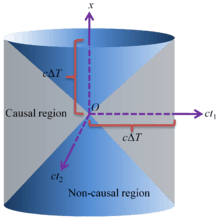Multiple time dimensions
The possibility that there might be more than one dimension of time has occasionally been discussed in physics and philosophy.
Physics
Special relativity describes spacetime as a manifold whose metric tensor has a negative eigenvalue. This corresponds to the existence of a "time-like" direction. A metric with multiple negative eigenvalues would correspondingly imply several timelike directions, i.e. multiple time dimensions, but there is no consensus regarding the relationship of these extra "times" to time as conventionally understood.
If the special theory of relativity can be generalized for the case of k-dimensional time (t1, t2, ..., tk) and n-dimensional space (xk + 1, xk + 2, ..., xk + n), then the (k + n)-dimensional interval, being invariant, is given by the expression
- (dsk,n)2 = (cdt1)2 + ... + (cdtk)2 − (dxk+1)2 − … − (dxk+n)2.
The metric signature will be
- (timelike sign convention)
or
- (spacelike sign convention).
The transformations between the two inertial frames of reference K and K′, which are in a standard configuration (i.e., transformations without translations and/or rotations of the space axis in the hyperplane of space and/or rotations of the time axis in the hyperplane of time), are given as follows:[1]
where are the vectors of the velocities of K′ against K, defined accordingly in relation to the time dimensions t1, t2, ..., tk; σ = 1, 2, ..., k; λ = k+2, k+3, ..., k+n. Here δσθ is the Kronecker delta. These transformations are generalization of the Lorentz boost in a fixed space direction (xk+1) in the field of the multidimensional time and multidimensional space.

Let us denote and where σ = 1, 2, ..., k; η = k+1, k+2, ..., k+n. The velocity-addition formula is then given by
where σ = 1, 2, ..., k; λ = k+2, k+3, ..., k+n.
For simplicity, let us consider only one spatial dimension x3 and the two time dimensions x1 and x2. (E. g., x1 = ct1, x2 = ct2, x3 = x.) Let us assume that in point O, having coordinates x1 = 0, x2 = 0, x3 = 0, there has been an event E. Let us further assume that a given interval of time has passed since the event E. The causal region connected to the event E includes the lateral surface of the right circular cone {(x1)2 + (x2)2 − (x3)2 = 0}, the lateral surface of the right circular cylinder {(x1)2 + (x2)2 = c2ΔT2} and the inner region bounded by these surfaces, i.e., the causal region includes all points (x1, x2, x3), for which the conditions
- {(x1)2 + (x2)2 − (x3)2 = 0 and |x3| ≤ cΔT} or
- {(x1)2 + (x2)2 = c2ΔT2 and |x3| ≤ cΔT} or
- {(x1)2 + (x2)2 − (x3)2 > 0 and (x1)2 + (x2)2 < c2ΔT2}
are fulfilled.[1]
Theories with more than one dimension of time have sometimes been advanced in physics, whether as a serious description of reality or just as a curious possibility. Itzhak Bars's work on "two-time physics",[2] inspired by the SO(10,2) symmetry of the extended supersymmetry structure of M-theory, is the most recent and systematic development of the concept (see also F-theory). Walter Craig and Steven Weinstein proved the existence of a well-posed initial value problem for the ultrahyperbolic equation (a wave equation in more than one time dimension).[3] This showed that initial data on a mixed (spacelike and timelike) hypersurface obeying a particular nonlocal constraint evolves deterministically in the remaining time dimension.
Connection to the Planck length and the speed of light
Let us regard the motion of a test particle with coordinate
which is the canonical (1,3) spacetime vector with extended by an additional timelike coordinate . is the second time parameter, describes the size of the second time dimension and is the characteristic velocity, thus the equivalent of . describes the shape of the second time dimension and is a normalization parameter such that is dimensionless. Decomposing with
and using the metric , the Lagrangian becomes
Applying the Euler-Lagrange Equations
the existence of the Planck length and the constancy of the speed of light can be derived.
As a consequence of this model it has been suggested that the speed of light may not have been constant in the early universe.[4]
Philosophy
Conceptual difficulties with multiple physical time dimensions have been raised in modern analytic philosophy.[5]
As a solution to the problem of the subjective passage of time, J. W. Dunne proposed an infinite hierarchy of time dimensions, inhabited by a similar hierarchy of levels of consciousness. Dunne suggested that, in the context of a "block" spacetime as modelled by General Relativity, a second dimension of time was needed in order to measure the speed of one's progress along one's own timeline. This in turn required a level of the conscious self existing at the second level of time. But the same arguments then applied to this new level, requiring a third level, and so on in an infinite regress. At the end of the regress was a "superlative general observer" who existed in eternity.[6] He published his theory in relation to precognitive dreams in his 1927 book An Experiment with Time and went on to explore its relevance to contemporary physics in The Serial Universe (1934). His infinite regress was criticised as logically flawed and unnecessary, although writers such as J. B. Priestley acknowledged the possibility of his second time dimension.[7][8]
See also
References
- 1 2 Velev, Milen (2012). "Relativistic mechanics in multiple time dimensions". Physics Essays. 25 (3): 403–438. Bibcode:2012PhyEs..25..403V. doi:10.4006/0836-1398-25.3.403.
- ↑ Bars, Itzhak. "Two-Time Physics". Retrieved 8 December 2012.
- ↑ Craig, Walter; Weinstein, Steven. "On determinism and well-posedness in multiple time dimensions". Proc. R. Soc. A vol. 465 no. 2110 3023-3046 (2008). Retrieved 5 December 2013.
- ↑ Albrecht, A.; Magueijo, J. "A Time Varying Speed of Light as a Solution to Cosmological Puzzles". Phys. Rev. D vol. 59 043516 (1999). Missing or empty
|url=(help) - ↑ Weinstein, Steven. "Many Times". Foundational Questions Institute. Retrieved 5 December 2013.
- ↑ McDonald, John Q. (15 November 2006). "John's Book Reviews: An Experiment with Time". Retrieved 8 December 2012.
- ↑ J.A. Gunn; The Problem of Time, Unwin, 1929.
- ↑ J.B. Priestley, Man and Time, Aldus, 1964.
External links
- Itzhak Bars, Gauge Symmetry in Phase Space, Consequences for Physics and Spacetime, Int. J. Mod. Phys. A 25 (2010) 5235-5252, arXiv:1004.0688 [hep-th].
- Itzhak Bars, John Terning, Extra dimensions in space and time, New York, Springer, Multiversal journeys series, 2010, ISBN 978-0-38777637-8. DOI 10.1007/978-0-387-77638-5.
